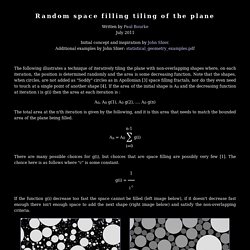

Lighthouse3d.com.
Mind-Blowing Research Into Inserting Artificial Objects into Photographs. Texture_colour/randomtile/paper.pdf. WebGL Water. Loading...

Made by Evan Wallace This demo requires a decent graphics card and up-to-date drivers. If you can't run the demo, you can still see it on YouTube. Interactions: Draw on the water to make ripples Drag the background to rotate the camera Press SPACEBAR to pause and unpause Drag the sphere to move it around Press the L key to set the light direction Press the G key to toggle gravity Features: Raytraced reflections and refractions Analytic ambient occlusion Heightfield water simulation * Soft shadows Caustics (see this for details) ** * requires the OES_texture_float extension** requires the OES_standard_derivatives extension Tile texture from zooboing on Flickr.
Unsorted. Environment Maps. News. Random space filling tiling of the plane. Written by Paul Bourke July 2011 Initial concept and inspiration by John Shier.

Additional examples by John Shier: statistical_geometry_examples.pdf The following illustrates a technique of iteratively tiling the plane with non-overlapping shapes where, on each iteration, the position is determined randomly and the area is some decreasing function. Note that the shapes, when circles, are not added as "Soddy" circles as in Apollonian [3] space filling fractals, nor do they even need to touch at a single point of another shape [4]. If the area of the initial shape is A0 and the decreasing function at iteration i is g(i) then the area at each iteration is : A0, A0 g(1), A0 g(2), .... The total area at the n'th iteration is given by the following, and it is this area that needs to match the bounded area of the plane being filled.
There are many possible choices for g(i), but choices that are space filling are possibly very few [1]. The total area for the infinite series is then given by : Institut für Computergraphik und Algorithmen - Arbeitsgruppe für Computergraphik.
2D. Lloyd Borrett - Computing - Play the Petals Around the Rose game (JavaScript) The name of the game is Petals Around the Rose.

The name of the game is important. The computer will roll five dice and ask you to guess the score for the roll. The score will always be zero or an even number. Your mission is to work out how the computer calculates the score and become a Potentate of the Rose. Instructions: Click on "Roll Dice" to start the game. Notice: Be amongst the first people to use Lloyd’s new discussion forums to share their experience with Petals Around the Rose.
Is Petals Around the Rose really a game? If you succeed in working out the secret to the challenge, you become a Potentate of the Rose and qualify to become a member of the Fraternity of Petals Around the Rose. Read what happened when Bill Gates was introduced to Petals Around the Rose in June 1977. Www.generative-modeling.org/GenerativeModeling/Documents/Dissertation-Havemann_print.pdf. Generative Modeling. Introduction Traditionally, 3D objects and virtual worlds are defined by lists of geometric primitives: cubes and spheres in a CSG tree, NURBS patches, a set of implicit functions, a soup of triangles, or just a cloud of points.

The term 'generative modeling' describes a paradigm change in shape description, the generalization from objects to operations: A shape is described by a sequence of processing steps, rather than just the end result of applying operations. Shape design becomes rule design. This approach is very general and it can be applied to any shape representation that provides a set of generating functions, the 'elementary shape operators'. Its effectiveness has been demonstrated, e.g., in the field of procedural mesh generation, with Euler operators as complete and closed set of generating functions for meshes, operating on the halfedge level.
The 'generative modeling language' GML is a concrete implementation of the generative approach. Mailing List.
Rendering.